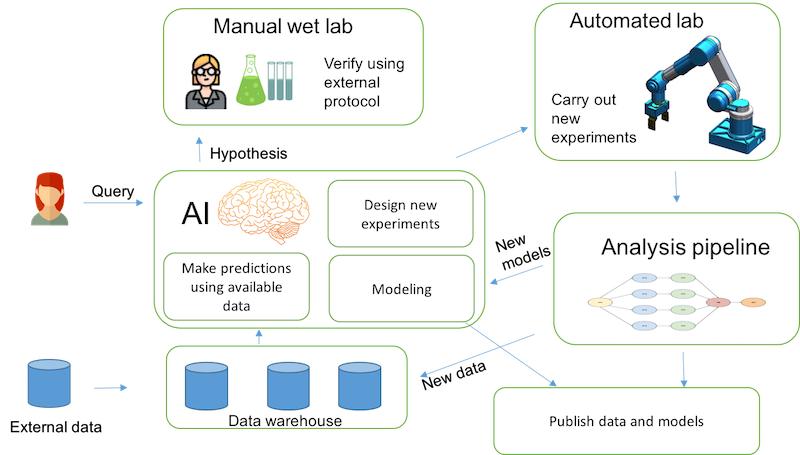Successful FORMAS grant proposal: Exploring toxicity mechanisms for environmental contaminants using an AI-controlled automated laboratory
15 Nov, 2018
Group leader Ola Spjuth received a 3 MSEK grant from the FORMAS Future Research Leaders call in 2018, for a project with the title:
Exploring toxicity mechanisms for environmental contaminants using an AI-controlled automated laboratory
As the number of potential harmful substances grows and the environmental load of many among those increases, there is an urgent need to accelerate the process to study and evaluate the potential toxic effects to humans. Current in vitro approaches for studying toxicity mechanisms and pathways are costly and have long iteration cycles because of manual lab operations and disconnected data analysis.
The purpose of this project is to improve studies of toxicity mechanisms and pathways for environmental contaminants with intelligent data generation, using an automated cell lab controlled by an AI system.
To this end, we will build and optimize a fully automated, robotized cell profiling laboratory with high-content imaging and develop the AI system and associated informatics infrastructure. The system will design and carry out experiments iteratively and learn with each iteration, and allow us to generate and collect the right data at the right time to answer specific questions related to toxicity. This constitutes a shift from traditional batch-oriented data generation followed by retrospective analysis, to intelligent design of experiments in an online setting in real time where scientific hypotheses are continuously tested and revised as new data is collected. The automated system will be supported by human operations for carrying out experiment with supportive or orthogonal methods, guided by the AI system.
The specific aims are:
Aim 1: Automate laboration and data collection. We will configure a fully automated lab with high-content microscopy imaging, and optimize protocols with respect to speed, costs, robustness and predictiveness. We will establish the supporting large-scale IT-infrastructure capable of managing and analyzing the collected large-scale data in real time. We will explore the synergistic collaboration between the automated lab and human operations.
Aim 2: Continuously test hypotheses and design follow-up experiments using AI. We will develop an AI system capable of testing hypotheses, intelligently designing follow-up experiments, controlling the automated lab to carry out experiments, guiding lab technicians, and learn on each iteration and revise hypotheses. We will use this system to test different hypotheses on mechanisms for environmental contaminants, and over time accumulate a valuable knowledge base.
Aim 3: Generate new hypotheses on toxicity mechanisms and pathways. When no acceptable hypotheses are available, we will in the automated system attempt to generate new hypotheses. These will then be tested by the AI within the automated lab, or carried out externally to the system, and will shed new light on the toxicity of environmental contaminants.

Figure: Overview of the iterative, AI-controlled process. Based on a scientific question or hypothesis to test, the AI makes predictions on existing data (external data integrated with in-house data) and designs new experiments to improve the hypothesis testing. New data is obtained, models are improved, and the process is iterated until desired confidence reached or termination criteria fulfilled. Complementing the system is human-controlled confirmatory or exploratory experiments. The produced images, data and models will all be made available online.

